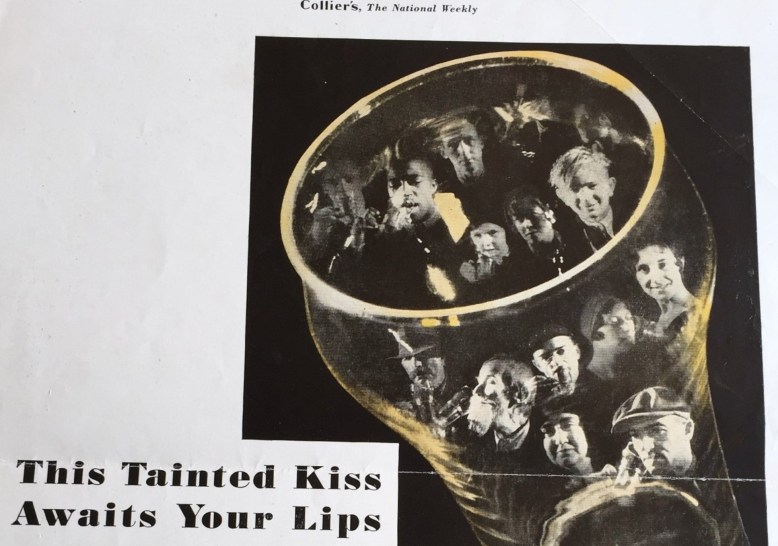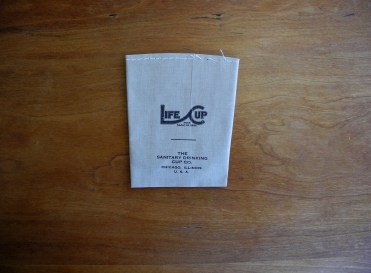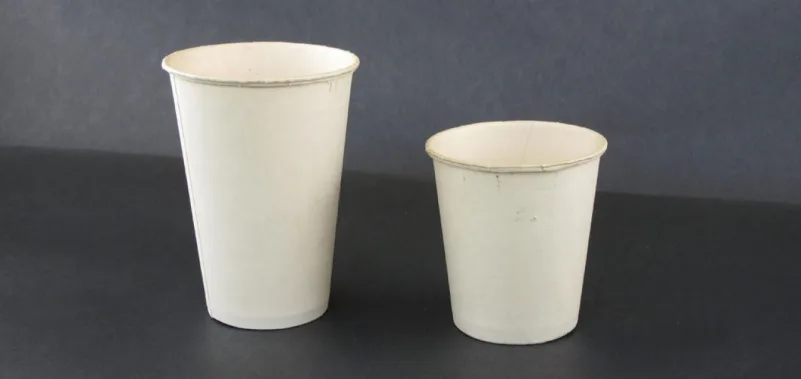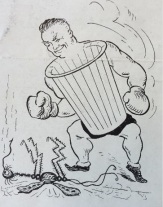
Dixie advertisement for Collier’s Magazine, 1931. (Hugh Moore Dixie Cup Company Collection, Special Collections and College Archives, Skillman Library, Lafayette College.)
What was the solution to the common drinking cup problem? For Boston inventor Lawrence Lullen and businessman Hugh Moore, along with many other eager entrepreneurs the solution was a portable or disposable individual drinking cup. What Moore and Lullen called “life-saving drinking technology” began to appear around the start of the twentieth century. At first these individual drinking cups were made of paper impregnated in paraffin or wax and users were able to fold them up for reuse. Soon cup manufacturers began to realize that more money could be made if the cups were disposable, made of paper, and easily ruined. To sell more cups to patrons, railroad companies, and other users, they had to make the cups hard to reuse.

Sanitary Drinking Cup Co., 1912. (Competitive company product sample. Hugh Moore Dixie Cup Company Collection, Special Collections and College Archives, Skillman Library, Lafayette College.)
One of the first sites where common drinking cups were replaced by disposable individual drinking cups was on trains. In 1909, the Lackawana Railroad proclaimed in an advertisement in The New York Press that by offering individual drinking cups on all through trains they were adding “a further touch to the comfortable and luxurious accommodations.” Patrons could now “obtain a cool drink of water…under perfect sanitary conditions.” Advertisements, like the one below, suggested that this sanitary alternative to the common drinking cup would make drinking water on trains a “treat.” As far north as Maine the individual drinking cup began appearing on railroads as the Portland ME Advertiser proclaimed in September of 1909.

Phoebe Snow advertisement for the Lackawanna Railroad, 1909. (Hugh Moore Dixie Cup Company Collection, Special Collections and College Archives, Skillman Library, Lafayette College.)
Although railroads began putting paper drinking cups on their trains, most did so through penny slot vending machines. Instead of patrons being able to drink water for free from the common drinking cup, they had to pay a penny every time they wished to have a sip of water. To combat this problem, some of the more experienced travelers brought their own paper cups with them. Some department stores, drug stores, and railroads sold personal cups that were reusable or sold packages of disposable paper cups that had their logo on them. Other travelers began to protest having to pay for a glass of water. Examples of both of these solutions can be seen below. In New Jersey for example railroads were ordered by The Public Utilities Commission that they had to “furnish their passengers with free individual drinking cups on trains.”
During the early years of the disposable drinking cup there was an explosion in the number of companies producing and selling paper cups. Not only were there many makers, there were also multiple designs for the cups themselves. Along with Health Kup (which ultimately became the well known Dixie Cup Company) other manufacturers included Baldwin Manufacturing Co, Puritan Sanitary Drinking Cups, Germless Paper Cup Co, Crystal Sterilized Drinking Co, Lily Cups, Tulip (which together with Lily Cup Company would form the later Dixie Cup rival Lily-Tulip Cup Company), “Sanifold,” National Drinking Cup Company, and many more. Each company produced distinct and unique individual paper cups, dispensers, and other accessories for sanitary drinking.
This call for sanitary and disposable drinking cups on public transportation continued through the Progressive Era and into the 1940s. In the “Sanitation Manual for Land and Air Conveyances Operating in Interstate Traffic” from 1943 it is clearly stated that “Single service cups are [to be] provided at all water coolers on land and air conveyances unless (1) drinking fountains are provided, or (2) facilities are available, for immediate use on the conveyance, to clean thoroughly the glasses, cups, etc., and subject them to the prescribed bactericidal treatment as required for glassware, utensils, and equipment used in dining cars having facilities for work of this kind.”
But travelers were not the only people concerned about sanitary drinking methods. Although individual, disposable drinking cups may have gotten their start on public transportation, they quickly diffused throughout society.Schools, hospitals, and offices solved problems of sanitation, efficiency, and convenience through a new emphasis on single-use disposability.








